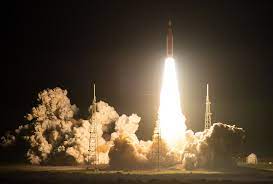New Deep Space Rocket Launch from NASA

NASA launches Artemis 1 into space. Courtesy of Joel Kowsky.
Artemis I, a new rocket launched by NASA, is on a mission to explore the moon’s orbiting structure, obtain unknown information about the moon, and establish a human presence on the moon. As of December 2022, Artemis I has traveled 1.3 million miles after it launched on November 16, 2022.
According to NASA documentation, the rocket begins its launch with the aid of two solid rocket boosters that burn through 6 tons of solid propellant per second to accelerate the rocket. However, Artemis I primarily propels itself using its SLS (Space Launch System) core stage. The stage contains two propellant tanks, multiple flight computers, and four RS-25 rocket engines. Towering 212 feet, the SLS core stage feeds the engines about 1,500 gallons of propellant each second for eight minutes, which is how long it takes SLS to reach Earth orbit. After entering Earth’s orbit, the rocket is propelled with its Cryogenic Propulsion stage, in which a single engine, powered by liquid hydrogen and oxygen, accelerates the rocket to follow its correct trajectory. The rocket plans to fly to and make one orbit 400 km above the lunar surface, then continue 64 thousand kilometers deeper into space. During this time, it will perform numerous experiments regarding deep space radiation, lunar study, and spacesuit effectiveness.
According to Space.com, the Artemis mission will give scientists a glimpse as to how a spacecraft will function in deep space environments, which will pave a path for future missions. Nasa sent Artemis I out back in November to see how the SLS rocket would do in space. It also provides insight into its capability to sustain itself throughout its journey to the moon. NASA scientists will be able to use the 13 small satellites carried by the SLS to perform experiments in space. The true significance of this Artemis mission is to one day land a person on Mars. Robots have already scavenged the land on Mars, and “NASA now aims to send astronauts there by the 2030s”.
Artemis I may be the first, but definitely not the last, in NASA’s exploration missions to come. On the NASA website, it states how, “[it] will be the first integrated flight test of NASA’s Deep Space Exploration Systems: the Orion spacecraft, Space Launch System (SLS) rocket, with the newly upgraded Exploration Ground Systems at Kennedy Space Center in Cape Canaveral, Florida.” In terms of the future of this rocket, it will soon enable and expand human exploration on the moon which may lead to innovative findings and a new perspective of Earth’s surroundings. Artemis I, formerly known as Exploration Mission-1 (EM-1), may also influence and forecast the exploration of Mars indirectly by comparing and contrasting the living conditions between the moon and Mars.
However, not everyone is satisfied with where the $93 billion dollars being spent on the rocket is going. Some say that the extensive cost is not worth the amount of risk involved to build on top of the environmental effects of space exploration. “The impossible problem today is not the moon. And it’s not Mars. It’s our home planet,” says former deputy NASA administrator Lori Garver.
By successfully launching Artemis I, NASA has proved that they are capable of releasing a complex rocket mission as well as even gaining more respect as they took account of all the minor changes and last-minute modifications in order for the mission to the moon to run smoothly.





